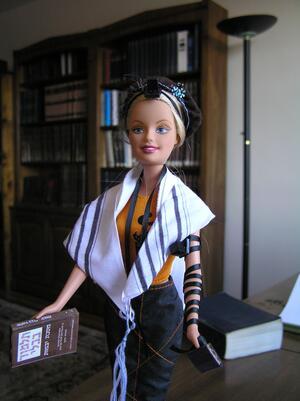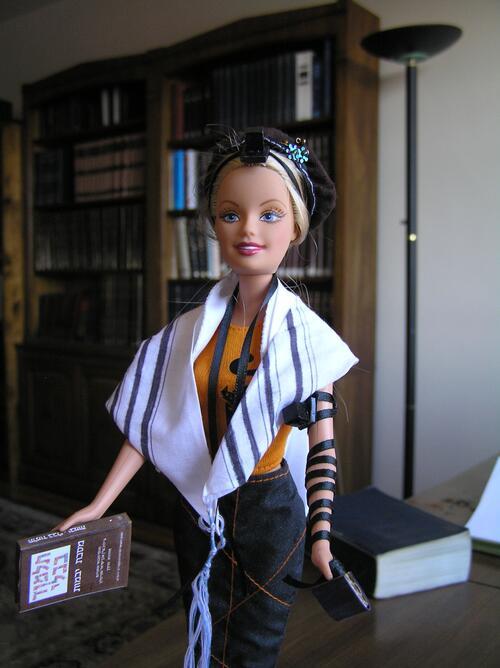The Barbie doll, launched in 1959 by Jewish businesswoman Ruth Handler, started out as a fashion model toy intended for young girls and has long since moved into the realm of cultural icon. Over the years, Barbie has been everything from fashion model to astronaut, from Olympic medalist to Hollywood movie star. In the 80s, she joined the multicultural movement and was depicted as African-American, Latina, and Asian. Her creators and followers have always strived to help Barbie adapt to the times and offer a variety of options for our imaginations. In her 1994 autobiography, Handler explained Barbie's true purpose: "My whole philosophy of Barbie was that through the doll, the little girl could be anything she wanted to be. Barbie always represented the fact that a woman has choices."
Barbie has also been the object of parody and criticism. Her unrealistic measurements have prompted many to worry that little girls might strive to look like Barbie and fail, causing low self esteem and poor body image. She thus represents an icon of beauty for millions, and for many others the embodiment of our culture's unrealistic expectations for women.
In 2006, Jen Taylor Friedman—one of the first soferot (female ritual scribes) in a male-dominated profession—gave Barbie a new look: she created a version of the famous doll sporting modest clothing, a tallit (prayer shawl) and her own miniature pair of tefillin (phylacteries). Tefillin Barbie—whose picture swept through the blogosphere—provokes reactions that range from disgust to shock to amusement to great admiration. Not unlike her secular counterpart, tefillin Barbie has continued to inspire much debate over whether she is to be taken seriously or to be considered a "bimbo" who might not be a good role model for girls considering whether to wear tallit and tefillin in their own Jewish lives.
However you see her, the sight of this blonde, blue eyed, cultural icon sporting the quintessentially Jewish and for some, very masculine, black tefillin can be jarring. Traditionally, women have not been considered obligated to wear tallit and tefillin, because doing so are time-bound commandments (that is, they must be done within a specific time frame), from which women are exempt according to Jewish law. This exemption from time-bound commandments has generally been interpreted as a prohibition. However, Jewish tradition also includes reports of some women who did wear tefillin, most notably the daughters of Rashi, the 11th century commentator.
As the record of Jewish legal debate illustrates, Judaism has always responded to social changes, adjusting tradition to incorporate new technologies and customs. In the modern era, as women's roles in secular society expanded, the Jewish community began to consider how religion and ritual, too, might be made more inclusive of women's participation. Each of the major Jewish denominations has addressed the issue of women's inclusion differently, according to their differing views on halakhah (Jewish law), but each has made changes to give women greater (and in some cases, new) roles within Jewish practice.
In the 19th century, the Reform movement began instituting mixed seating, which integrated women into the main space of the synagogue. In 1890, Ray Frank became the first woman to preach from the pulpit. Since then, the liberal movements (Reform, Conservative, and Reconstructionist) have included women in other ways, such as counting women in the minyan (prayer quorum), allowing women to chant from the Torah and serve as a prayer leader, marking a girl's bat mitzvah with a meaningful ceremony, and ordaining women as rabbis—the first was Rabbi Sally Priesand, ordained by the Reform movement in 1972. (The Reconstructionist movement ordained its first woman rabbi in 1974 and the Conservative Movement in 1985.) Even the Orthodox community, which has the most rigid understanding of Jewish law, has expanded the roles that women can play to include teaching of traditional texts, giving sermons, and making certain kinds of legal decisions. In 2006, an Orthodox woman was even ordained by an Israeli Orthodox rabbi (though most Orthodox people do not accept her ordination). In 2013, an institution that ordains orthodox women as spiritual leaders called Yeshivat Maharat graduated its first class of female clergy members.
Despite these strides toward the inclusion of women in ritual practice, some women continue to feel uncomfortable wearing ritual garb—such as kippah, tallit, and tefillin—that have long been considered male. Some women have tried to make ritual garb their own by "feminizing" it—for example, creating tallitot with silks, designs, and brighter colors, and kippot with larger crochet and even beads. But because the form of tefillin is determined by halakhah (e.g. they must be made out of black leather), they have not been changed and therefore remain, for some, inherently masculine.
In this context, then, the juxtaposition of super-feminine Barbie and the traditionally masculine deep black leather straps of tefillin may be startling, but what it signifies is open to interpretation. Certainly, women's feelings and preferences regarding ritual garb are at once very personal and also reflective of communal norms. The relationship between women and rituals such as tallit and tefillin requires continued consideration and conversation, and whether you see tefillin Barbie as an empowering figure or a satirical one, she is undoubtedly a provocative starting point for communal discussion.





Any idea where we might be able to purchase such a Barbie ?
Thank you